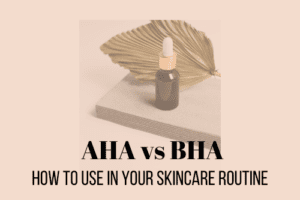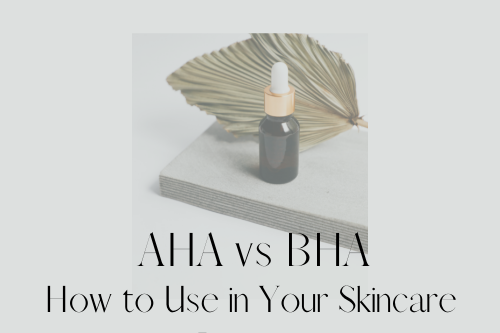 AHA vs BHA? How do you incorporate them into your skincare routine? AHA and BHA are two different types of acids commonly found in skincare products for the purpose of banishing breakouts or evening skin tone and texture.
AHA vs BHA? How do you incorporate them into your skincare routine? AHA and BHA are two different types of acids commonly found in skincare products for the purpose of banishing breakouts or evening skin tone and texture.
You see the combination of those 3 letters all over skincare products. So how do you know which one is right for you? Should you be using both?
Essentially they are both exfoliants that work to eliminate dead skin cells, control oil production, and keep pores cleaned out. One is not superior to the other, rather they are used to treat different concerns.
What is AHA
Alpha hydroxy acids (AHA) are a water soluble acid that exfoliates dead skin cells. It can be derived from cane sugar, fruits, or milk. Because it is water soluble, it only penetrates the superficial layers of the skin.
Glycolic and Lactic acid are the most common stand alone acids you’ll see on the front of a product bottle. Glycolic is the strongest of the two and contains the smallest molecules, which you’ve probably heard me speak on before if you have followed me for any length of time. My favorite toner’s active ingredient is glycolic acid, which I love to use to increase the potency of my products that follow the toner. Because the glycolic molecule is so small, it can penetrate the skin deeper and creates a channel for the products applied after, to follow.
Lactic acid is the most gentle AHA but is potent enough to stand alone. If you get easily irritated from active ingredients, lactic acid is a great place to start.
Other AHAs including malic and mandelic acids are less potent, thus you’ll see them paired with other AHAs as an adjunct to increase effectiveness and potency.
Citric and Tartaric acids are in the AHA family, although commonly used to stabilize more potent AHAs.
Benefits of AHA
AHA chemically exfoliates to remove dead skin cells, which can have many benefits. As we age our skin cells tend to build up as the renewal cycle slows down. By exfoliating with an AHA, the dead skin cells are shed and your skin will appear brighter and more youthful.
Acne is caused from pores getting clogged from dead skin cell build up, sebum (oil), and bacteria. By using an AHA, dead skin cells are shed and unable to clog the pore as readily.
Fine lines and wrinkles are accentuated by buildup of dead skin cells and decreased collagen production. By adding in an AHA to your skincare routine appearance of fine lines and wrinkles are reduced by increased collagen production
Discoloration or pigmentation changes can be reversed when using an AHA, although caution is to be taken because AHAs have been know to cause pigmentation changes due to irritation. If becoming irritated with AHA use, back down to a few times a week to avoid irritation.
Lastly, by exfoliating the outermost layer of the skin, product absorption is increased as there is not as thick of an epidermis to penetrate. Also, as mentioned previously, especially with glycolic acid used to drive products deeper within the skin.
What is BHA
Beta hydroxy acid (BHA) is very similar in chemical makeup to alpha hydroxy acids, although the main difference is BHA is an oil soluble acid. This means it can be readily absorbed through oily skin and penetrate deeper into the dermis and even into the pores. BHAs are derived from plants such as certain leaves and barks.
The most commonly known BHA is salicylic acid, seen in many over the counter acne treatments. A more natural form of BHA is willow bark extract.
Benefits of BHA
BHAs mainly work on the keratin of the skin. Keratin is the main protein skin maintaining our skin barrier and structure. Although keratin is vital for the function of our skin, it can over produce cells causing pores to clog.
BHAs work to regulate production of keratin, making sure it’s not too slow or too fast because both can cause skin issues. They will also remove build up within pores which eventually become acne (comedones). CLICK HERE to read more about acne and how to treat.
How to incorporate AHA and BHA in your skincare
AHA and BHA work great together, although when starting to incorporate both into the skincare routine I recommend letting your skin acclimate to one and then adding another or purchasing a product that has both already. Professional formulation will take the guesswork out of what can be tolerated together for most skin types.
A great option is to use a BHA in the morning and AHA at night to prevent irritation as well.
Acne Prone Skin: BHA (Salicylic Acid) is the best option to clean out the pores.
Dry, Sensitive Skin: (AHA) Lactic Acid as it is the most gentle AHA
Fine Lines and Wrinkles: (AHA) Glycolic and (BHA) Salicylic acid alone or together
Discoloration or Pigmentation: (AHA) Glycolic although AHA is known to cause irritation which leads to post inflammatory hyperpigmentation. If you feel your skin is too sensitive for glycolic acid opt for (BHA) Salicylic Acid
Products
The Ordinary Lactic Acid 10% + HA (AHA)
- Great solution to use 2-3 times a week or even daily as tolerated
The Ordinary AHA 30% + BHA 2% Peel Solution (AHA + BHA)
- Use once a week as a peeling masque
Dr. Dennis Gross Peel Pads (AHA + BHA)
- Recommended to use nightly as tolerated. This also has retinol within the product.
Neutrogena Rapid Clear Pads (BHA)
- Affordable salicylic acid toner for acne prone skin. Use once a day if not tolerated twice daily after washing.
Caudalie Vinoperfect Brightening Essence (AHA)
- Gentle glycolic toner to be used after cleansing twice a day as tolerated.
SkinCeuticals LHA Cleanser (AHA)
- Lactic acid cleanser recommended to use a few times a week or daily as tolerated.
Glytone Acne Treatment Spray (BHA)
- Perfect solution for on the go after workouts or as a toner after cleansing.
